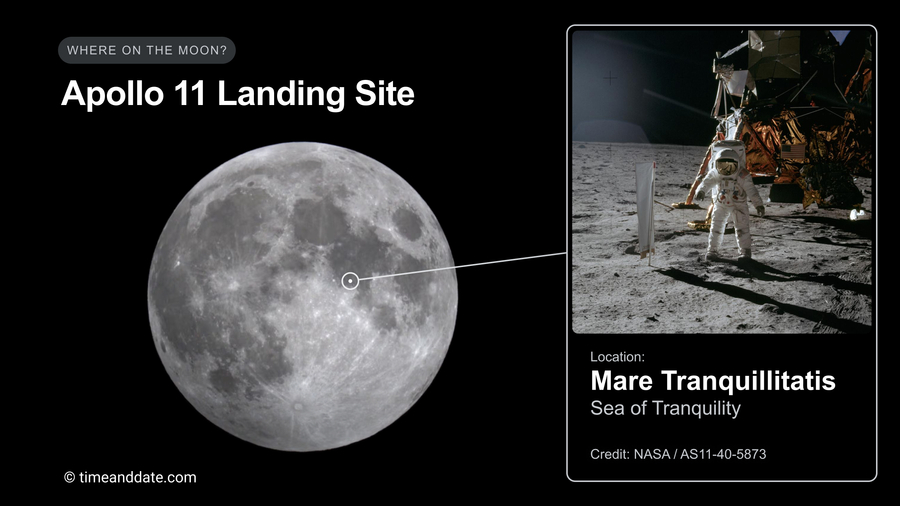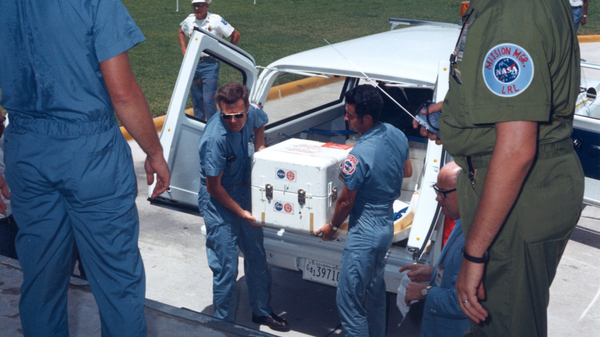
One Giant Leap for Mankind
July 20 is one of the most significant dates in human history: On this day in 1969, humans landed for the first time on another celestial body. Apollo 11 astronauts Neil Armstrong and Buzz Aldrin touched down in Mare Tranquillitatis—the Sea of Tranquility—at 20:17 UTC.
This year, July 20 will be the 56th anniversary of an event that forever changed the way we look at the Moon.
How to See Mare Tranquillitatis
We’ve marked the location of the Apollo 11 landing site—on the edge of Mare Tranquillitatis—in the illustration at the top of this page. Like all of the Moon’s “seas,” Mare Tranquillitatis is a large plain of ancient lava that appears dark when seen from Earth.
As the Moon goes through its cycle of
In 1969, First Quarter Moon was on July 22—in other words, the Sun had just risen over Mare Tranquillitatis when the “Eagle” lunar module landed on July 20. Needless to say, this was deliberate! The Moon’s surface was still cool, and the long shadows helped with navigation.
In 2025, First Quarter is on July 2, while Third Quarter is July 18. This means that the Apollo 11 landing site will be in darkness on the actual day of its 56th anniversary.
Why Mare Tranquillitatis?
We asked NASA’s Noah Petro to tell us more about the Apollo 11 landing site. He does so below—and encourages all of us to go out, look up, and see the Moon as part of our neighborhood.
The simple phrase “Tranquility Base here, the Eagle has landed” helped usher in a new era of science and exploration. Over the past 56 years, that singular event—and all that lead to the success of Apollo 11—has resonated with the public and marks a transformative event for humans.

Dr. Noah Petro is the Project Scientist for NASA’s Artemis III mission, as well as for the agency’s Lunar Reconnaissance Orbiter (LRO), which has been orbiting the Moon since 2009. Dr. Petro is also the Chief of NASA’s Planetary Geology, Geophysics and Geochemistry Laboratory at NASA’s Goddard Space Flight Center in Greenbelt, Maryland.
But why Mare Tranquillitatis?
Located in the eastern hemisphere of the Moon, the region targeted by Apollo 11 had been identified years prior as a candidate landing site and explored by prior robotic spacecraft Ranger 8 (impactor) and Surveyor 5 (lander). It was also flown over by the Apollo 10 mission.
These precursor missions showed that the surface was relatively smooth, free of hazards, and would meet the criteria for a safe landing—and most importantly departure!
What was not a factor in the landing site was what would be sampled there. It was expected that the samples collected by Apollo 11 would be volcanic, but that was a hypothesis that would be tested. Little specific was known about the age of the surface (is it young or ancient?), or specific chemistries of the rocks.
The prior Surveyor missions provided some information on the surfaces where those missions landed, but what Apollo provided—the return of samples and deployment of additional experiments—is where the Apollo missions provided the real scientific leaps. Once the samples were returned to the Earth, less than a week after they were collected, the scientific bonanza began.

I would challenge every reader to go out and look at the Moon and learn where Apollo 11 landed (it’s a great party trick), but don’t stop there, learn all the landing sites and major features. Test yourself by drawing the Moon, labeling its features, and making the Moon part of your mental map of the world.
As a shared object, and something so close to Earth, we should treat the Moon as part of our neighborhood and learn its face. In the coming year we’ll have humans flying past the Moon with Artemis II. We’ll then be landing on it and orbiting it with Artemis III. Just as Tranquility Base became part of our lexicon, in the coming years new lunar places will enter our cultural dialogue. What an exciting time to be looking up!
A Shared Object
Thanks to Noah Petro for contributing the above text to this article. Noah is an old friend of timeanddate.com—you can see him below in our live stream as he shares his experience of the November 2022 total lunar eclipse.
Dates in this article are given in UTC.
